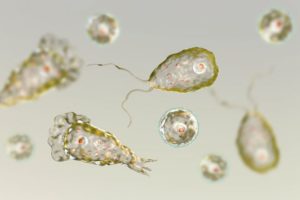Another Amoeba Death Blamed on a Waterpark
by Rebecca Robledo
Another man has died after allegedly contracting the brain-eating amoeba at a waterpark.
Eddie Gray, 59, was on a trip with his church at Fantasy Lake Water Park in Hope Mills, N.C. when he contracted Naegleria fowleri, known as the brain-eating amoeba. He died 10 days later.
A manmade lake serves as the anchor for the facility, with water slides built on it and activities taking place in it.
This is at least the second incident in a year. The issue gained national attention in 2018, when a 29-year-old man died from the amoeba after visiting a Texas surf park.
Government officials have turned their attention to the issue of water quality in larger bodies of water such as manmade lakes and surf parks. Florida and Texas are both considering codes to regulate these installations.
______________
Rebecca Robledo is deputy editor of Pool & Spa News and Aquatics International. She is an award-winning trade journalist with more than 25 years experience reporting on and editing content for the pool, spa and aquatics industries. She specializes in technical, complex or detail-oriented subject matter with an emphasis in design and construction, as well as legal and regulatory issues. For this coverage and editing, she has received numerous awards, including four Jesse H. Neal Awards, considered by many to be the “Pulitzer Prize of Trade Journalism.”
___________________
Why the “Brain-Eating” Amoeba is so Deadly by Bill Sullivan
Composed of a single cell, amoeba seem harmless enough: They look like playful critters waltzing under the spotlight of a microscope until they come upon a group of bacteria. Then, these previously innocuous amoeba suddenly morph into sinister blobs, engulfing the bacteria and slowly ripping them apart with a bevy of digestive enzymes. It’s hard to cry over murdered bacteria, but the digestive power of amoeba is the stuff of nightmares when it plays out in a human brain.
Infections with Naegleria fowleri, the so-called brain-eating amoeba, are extremely rare, but also extremely deadly. Only 146 cases have been reported in the U.S. since 1962, with only four surviving the infection; so there is a 97% chance of death. Sadly, on July 22, a 59-year-old North Carolina man became the first person to die of the infection this year after swimming in a lake at a water park.
I study parasites and have a particular interest in those that target the brain, which is why this amoeba captured my interest.
N. fowleri dwells in warm bodies of fresh water where it dines on bacteria in the sediment. As such, most infections with this amoeba in the U.S. have occurred in southern states, especially Texas and Florida, during the summer. When the sediment of a lake is disrupted, amoeba get stirred into the water. Swimmers can then inhale the parasite through their nose. From there, N. fowleri invades the olfactory nerves and migrates to the brain, where it causes a dangerous condition called primary amoebic meningoencephalitis.


